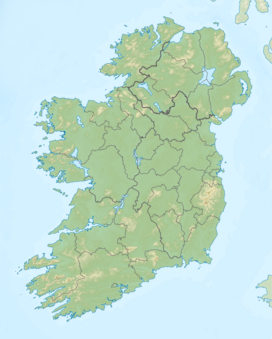| Mullaghmeen | |
|---|---|
| (Mullach Mín) | |
 Mullaghmeen Hill viewed from Coole Mullaghmeen Hill viewed from Coole | |
| Highest point | |
| Elevation | 258 m (846 ft) |
| Prominence | 146 m (479 ft) |
| Listing | County top (Westmeath) |
| Coordinates | 53°45′43″N 7°17′21″W / 53.762078°N 7.289195°W / 53.762078; -7.289195 |
| Naming | |
| English translation | smooth summit |
| Language of name | Irish |
| Geography | |
 | |
| Location | Westmeath, Ireland |
| Parent range | Westmeath Hills |
| OSI/OSNI grid | N469793 |
| Topo map | OSi Discovery 41 |
| Geology | |
| Mountain type(s) | Undifferentiated limestone, (Visean Limestones (undifferentiated)) |
Mullaghmeen (Irish: Mullach Mín, meaning 'smooth summit'), at 258 metres (846 ft), is the county top for Westmeath in Ireland, and is the lowest county top in Ireland. Mullaghmeen is located in the Mullaghmeen Forest, known for having the largest planted beech forest in Europe.
Geography

Mullaghmeen lies in the northern tip of County Westmeath, just inside the border with County Meath, and looks into the northern Lough Sheelin, which forms the border with County Cavan. The hill is 16 km north of the town of Castlepollard. At 258 metres (846 ft), the summit of Mullaghmeen is the highest point in County Westmeath, however, it is the lowest county top in Ireland. The soil of Mullaghmeen is limestone, and in 1936 the Department of Agriculture decided it would be suited to the planting of deciduous trees, and created the 400 ha Mullaghmeen Forest, the largest planted beech forest in Europe.
Hill walking

Mullaghmeen is described as a difficult mountain to find, and while its summit is of modest height, it is well-regarded as part of one of the several 2–3 hour circa 6 mile forest loop-walks through the Mullaghmeen Forest. Most start at the car-park just beyond the entrance to Mullaghmeen Forest (at N479779) and take in the summit of Mullaghmeen as well as other landmarks, such as the Booley Hut, the Famine Garden, the Flax Pits, and the Woodland Arboretum.
See also
- Lists of mountains in Ireland
- List of Irish counties by highest point
- List of mountains of the British Isles by height
References
- ^ MountainViews: Mullaghmeen
- Paul Tempan (February 2012). "Irish Hill and Mountain Names" (PDF). MountainViews.ie.
- ^ Paul Clements (16 March 2016). The Height of Nonsense: The Ultimate Irish Road Trip. Collins Press. pp. 147–153. ISBN 978-1848892651.
- ^ Francis Bradley (25 April 2009). "Go Walk: Mullaghmeen Forest, Co Westmeath". Irish Times.
This little nugget is in Mullaghmeen Forest, in north Co Westmeath, just beside the county border with Co Meath. The park has Europe's largest planted beech forest and is also home to Sitka spruce, Scots pine, noble fir and a fine native tree collection.
- "MULLAGHMEEN FOREST". Coillte. Retrieved 1 January 2019.
- Christopher Somerville (10 September 2010). "Walk of the week: Mullaghmeen Forest, Co Westmeath". Irish Independent.
There are woodland walks so boring you think you'll scream if you see another wretched conifer; and then there are woodland walks like those in Mullaghmeen Forest up in the northernmost tip of Co Westmeath.
External links
- MountainViews: The Irish Mountain Website Mullaghmeen
- MountainViews: Irish Online Mountain Database
- The Database of British and Irish Hills , the largest database of British Isles mountains ("DoBIH")
- Hill Bagging UK & Ireland, the searchable interface for the DoBIH
- Ordnance Survey Ireland ("OSI") Online Map Viewer
- Logainm: Placenames Database of Ireland
| Mountains and hills of Great Britain and Ireland | ||
|---|---|---|
| British Isles |  | |
| Scotland | ||
| Outside Scotland | ||
| England | ||
| Ireland | ||
| County tops | ||
